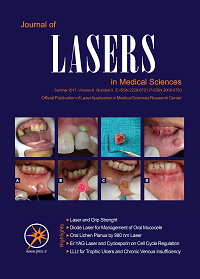Role of Flt4 in Skin Protection against UVB Radiation: A System Biology Approach The Role of Flt4 in Skin Protection against UVB Radiation
Journal of Lasers in Medical Sciences,
Vol. 11 No. Supplement (2020),
30 December 2020
,
Page S30-S36
Abstract
Background: Although the application of ultraviolet B (UVB) in phototherapy of human skin is a common therapeutic method, it is known as a risk factor for skin cancer. This study aims to assess the role of differentially expressed genes (DEGs) to find the critical one that is mainly responsible for skin protection against UVB radiation.
Methods: The gene expression profiles of irradiated mice by UVB that issued skin protection against exposure are extracted from Gene Expression Omnibus (GEO) and analyzed by GEO2R. The significant DEGs are assessed via gene ontology (GO) analysis and the critical individuals are investigated via action mapping.
Results: Thirty-eight significant DEGs that provide skin resistance against UVB irradiation were determined. Among the query DEGs, 26 individuals were related to 43 biological terms. Flt4, F3, Tspan6, Cblb, and Itgb6 were highlighted as the critical DEGs to promote skin protection against UVB irradiation.
Conclusion: The finding indicates that Flt4 is the key DEG that is mainly responsible for protecting skin from UVB exposure.
- UVB; Skin; Mouse; Gene ontology; Flt4
How to Cite
References
De Gruijl FR. Skin cancer and solar UV radiation. Eur J Cancer. 1999;35(14):2003-9. doi: 10.1016/S0959-8049(99)00283-X.
Bode AM, Dong Z. Mitogen-activated protein kinase activation in UV-induced signal transduction. Sci Signal. 2003;2003(167):re2. doi: 10.1126/stke.2003.167.re2.
Pasker-de Jong PC, Wielink G, van der Valk PG, van der Wilt GJ. Treatment with UV-B for psoriasis and nonmelanoma skin cancer: a systematic review of the literature. Arch Dermatol. 1999;135(7):834-40. doi: 10.1001/archderm.135.7.834.
Scherschun L, Kim JJ, Lim HW. Narrow-band ultraviolet B is a useful and well-tolerated treatment for vitiligo. J Am Acad Dermatol. 2001;44(6):999-1003. doi: 10.1067/mjd.2001.114752.
Ramsay DL, Lish KM, Yalowitz CB, Soter NA. Ultraviolet-B phototherapy for early-stage cutaneous T-cell lymphoma. Arch Dermatol. 1992;128(7):931-3.
Lee E, Koo J, Berger T. UVB phototherapy and skin cancer risk: a review of the literature. Int J Dermatol. 2005;44(5):355-60. doi: 10.1111/j.1365-4632.2004.02186.x.
Edgar R, Domrachev M, Lash AE. Gene Expression Omnibus: NCBI gene expression and hybridization array data repository. Nucleic Acids Res. 2002;30(1):207-10. doi: 10.1093/nar/30.1.207.
Babichev S, Škvor J. Technique of gene expression profiles extraction based on the complex use of clustering and classification methods. Diagnostics (Basel). 2020;10(8):584. doi: 10.3390/diagnostics10080584.
Zamanian-Azodi M, Rezaei-Tavirani M, Rezaei Tavirani M. Investigating the effects of ibuprofen on the gene expression profile in Hippocampus of mice model of Alzheimer’s disease through bioinformatics analysis. Iran J Pharm Res. 2020;19(2):352-9. doi: 10.22037/ijpr.2019.15485.13125.
Amiri-Dashatan N, Rezaei-Tavirani M, Ahmadi N. A quantitative proteomic and bioinformatics analysis of proteins in metacyclogenesis of Leishmania tropica. Acta Trop. 2020;202:105227. doi: 10.1016/j.actatropica.2019.105227.
Rostami-Nejad M, Razzaghi Z, Esmaeili S, Rezaei-Tavirani S, Akbarzadeh Baghban A, Vafaee R. Immunological reactions by T cell and regulation of crucial genes in treated celiac disease patients. Gastroenterol Hepatol Bed Bench. 2020;13(2):155-60. doi: 10.22037/ghfbb.v13i2.1921.
Manikyam HK. Computational studies on Gene Ontology for Molecular functions, Cellular component and Biological process of SARS-CoV-2 targeted proteins, 04 May 2020, PREPRINT (Version 1) available at Research Square: https://doi.org/10.21203/rs.3.rs-26263/v1
Barghi N, Bambaeichi E, Rezaei-Tavirani M, Khaledi N. Aerobic exercises induce antioxidant pathways activation in rats. Int J Prev Med. 2020;11:144. doi: 10.4103/ijpvm.IJPVM_246_19.
Singh TP, Vieyra-Garcia PA, Wagner K, Penninger J, Wolf P. Cbl-b deficiency provides protection against UVB-induced skin damage by modulating inflammatory gene signature. Cell Death Dis. 2018;9(8):835. doi: 10.1038/s41419-018-0858-5.
Rezaei Tavirani M, Rezaei Tavirani S, Tajik Rostami F. Biochemical pathway analysis of gastric atrophy. Gastroenterol Hepatol Bed Bench. 2018;11(2):118-24.
Karbalaei R, Piran M, Rezaei-Tavirani M, Asadzadeh-Aghdaei H, Heidari MH. A systems biology analysis protein-protein interaction of NASH and IBD based on comprehensive gene information. Gastroenterol Hepatol Bed Bench. 2017;10(3):194-201.
Brand RM, Wipf P, Durham A, Epperly MW, Greenberger JS, Falo Jr LD. Targeting mitochondrial oxidative stress to mitigate UV-induced skin damage. Front Pharmacol. 2018;9:920. doi: 10.3389/fphar.2018.00920.
Balestrin LA, Bidone J, Bortolin RC, Moresco K, Moreira JC, Teixeira HF. Protective effect of a hydrogel containing Achyrocline satureioides extract-loaded nanoemulsion against UV-induced skin damage. J Photochem Photobiol B. 2016;163:269-76. doi: 10.1016/j.jphotobiol.2016.08.039.
Mohania D, Chandel S, Kumar P, Verma V, Digvijay K, Tripathi D, et al. Ultraviolet radiations: Skin defense-damage mechanism. In: Ahmad SI, editor. Ultraviolet light in human health, diseases and environment. Cham, Switzerland: Springer; 2017. p. 71-87.
Dilsiz N. Role of exosomes and exosomal microRNAs in cancer. Future Sci OA. 2020;6(4):FSO465. doi: 10.2144/fsoa-2019-0116.
Meecham A, Marshall JF. The ITGB6 gene: its role in experimental and clinical biology. Gene X. 2020;5:100023. doi: 10.1016/j.gene.2019.100023.
Dotan I, Allez M, Danese S, Keir M, Tole S, McBride J. The role of integrins in the pathogenesis of inflammatory bowel disease: Approved and investigational anti‐integrin therapies. Med Res Rev. 2020;40(1):245-62. doi: 10.1002/med.21601.
Zhang Y, Reif G, Wallace DP. Extracellular matrix, integrins, and focal adhesion signaling in polycystic kidney disease. Cell Signal. 2020;72:109646. doi: 10.1016/j.cellsig.2020.109646.
Gauvrit S, Villasenor A, Strilic B, Kitchen P, Collins MM, Marín-Juez R, et al. HHEX is a transcriptional regulator of the VEGFC/FLT4/PROX1 signaling axis during vascular development. Nat Commun. 2018;9(1):2704. doi: 10.1038/s41467-018-05039-1.
Sui Y, Lu Y, Lin M, Ni X, Chen X, Li H, et al. A Milroy Disease Family Caused by FLT4 Gene Mutation of c.2774 T>A with Phenotypes Heterogeneity, 05 October 2020, PREPRINT (Version 1). available at Research Square: https://doi.org/10.21203/rs.3.rs-44896/v1
Reuter MS, Chaturvedi RR, Liston E, Manshaei R, Aul RB, Bowdin S, et al. The cardiac genome clinic: implementing genome sequencing in pediatric heart disease. Genet Med. 2020;22(6):1015-1024. doi: 10.1038/s41436-020-0757-x.
Bhattacharjee S, Lee Y, Zhu B, Wu H, Chen Y, Chen H. Epsins in vascular development, function and disease. Cell Mol Life Sci. 2020. doi: 10.1007/s00018-020-03642-4.
- Abstract Viewed: 564 times
- PDF Downloaded: 322 times
